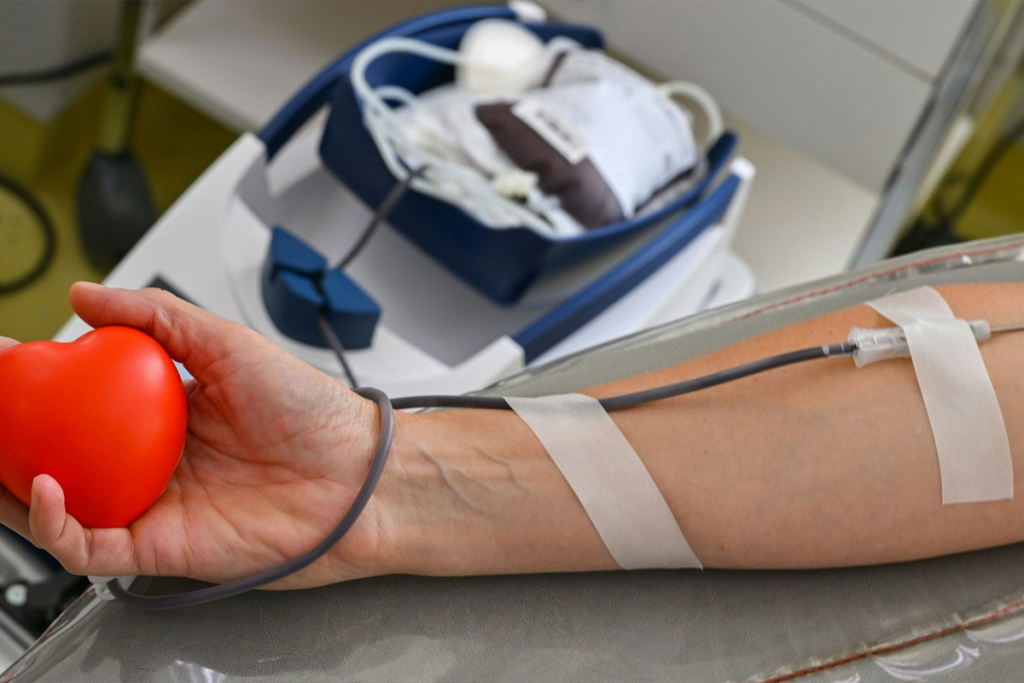Blood transfusions are vital in medicine, but they come with blood transfusion risks and complications. The 2024 UK SHOT report shows a risk of death from transfusions at about 1 in 37,000 blood components. Serious harm happens in 1 in 11,500 cases.

These numbers stress the need to know the risks and complications of blood transfusions. As healthcare workers, we must understand these risks. This knowledge helps us provide better and more ethical care to our patients.
It’s important to know how blood transfusions work. They help treat serious health issues. This makes them key in today’s medicine.
A blood transfusion is when donated blood is given to someone who needs it. The blood types of the donor and receiver must match to avoid bad reactions. Different parts of the blood, like red blood cells, plasma, and platelets, can be given based on what the patient needs.

Blood transfusions are often needed for anemia, when there aren’t enough red blood cells. They’re also used in surgeries and for those who have lost a lot of blood. Transfusions help people with bleeding problems or those getting treatments that affect their blood.
Blood transfusions save lives but come with risks. Healthcare teams and patients must weigh these risks. As medical tech improves, knowing these risks is key to better care.
The 2024 UK SHOT report sheds light on blood transfusion risks. It shows a 1 in 37,000 chance of death from transfusions. Serious harm risks are even higher, at 1 in 11,500.
These numbers highlight the need for strict screening and close patient watch.

It’s important to compare these risks with other medical steps. Blood transfusions have big risks, but so do surgeries and some tests. The risk of death or serious harm can be similar or even higher.
Looking at these numbers helps us see why transfusion medicine and patient care must keep getting better.
TACO is a big problem in blood transfusions. It’s important to know why it happens and how to stop it. TACO makes the body’s circulatory system too full, causing breathing problems and serious health risks.
TACO is now the leading cause of death from blood transfusions. In 2024, it caused 31 deaths, a big jump from 2023. This shows we need to be more careful and take steps to prevent it.
The main reasons for TACO are:
To lower the risk of TACO, doctors should watch patients closely during transfusions. They should also prevent too much fluid in the body. Ways to do this include:
By learning about TACO and using prevention methods, we can make blood transfusions safer. This helps protect patients who need them.
Blood transfusions carry a risk of spreading infectious diseases, despite strict screening. Viruses like hepatitis B, hepatitis C, and HIV are major concerns. We will look at these risks and how we try to lower them.
The chance of getting hepatitis B from blood donations is about 1 in 300,000. The risk of HIV is 1 in 2 million. Thanks to strict donor checks and advanced tests, these risks are much lower. Modern blood screening has cut down the time it takes to find these viruses, making transfusions safer.
Risks of infection change based on where you are. Places with more hepatitis cases have a higher risk of blood-borne infections. Knowing these differences helps us tailor screening to each area.
New screening tools, like nucleic acid testing (NAT), help find viruses in blood donations. A study showed that NAT has made blood safe, as this research paper explains. We keep improving these methods to lower disease transmission risks.
By carefully choosing donors, using the latest screening, and always checking, we make blood transfusions safer. This ensures the blood supply is safe for everyone.
Blood transfusions are lifesaving but can cause noninfectious complications. These issues can affect a patient’s quality of life. They are not caused by infectious agents but are serious.
Even with the right blood type, allergic reactions can happen. Symptoms range from mild to severe. Prompt recognition and management are key to avoiding serious problems.
We treat mild reactions with antihistamines. Severe reactions need epinephrine right away.
Hemolytic reactions happen when the immune system attacks transfused red blood cells. This can lead to fever, chills, and even kidney failure. Pre-transfusion testing helps prevent these reactions.
Delayed reactions can occur days after transfusion. They happen when the body remembers antigens from past transfusions. We watch for signs like low hemoglobin or hemolysis.
Understanding and managing non-infectious transfusion reactions is key to safer transfusions. By knowing the causes and how to treat them, we can improve patient care.
Recent data shows that human error is a big cause of transfusion incidents. This highlights the importance of staying alert. We will look into why human error is a big problem in transfusions. We will also talk about how to reduce these errors.
A shocking 83% of all transfusion incidents are due to human mistakes, as LivHospital reports. This shows how vital it is to improve training, protocols, and watchfulness in transfusions.
There are many reasons for human error in transfusions. These include:
To lower these risks, healthcare providers can take several steps. These include:
By knowing the reasons for human error and taking action, we can greatly cut down transfusion incidents. This will make patients safer.
The quest to make blood transfusions safer has led to big steps forward. We now have better screening, testing, and patient monitoring. It’s key to know the new ways we’re making transfusions safer.
New screening and testing methods are key to reducing risks. Nucleic acid testing (NAT) and pathogen reduction technologies help find and kill pathogens in blood. These steps have greatly lowered the chance of getting sick from blood transfusions.
Keeping a close eye on patients is vital for spotting and handling transfusion reactions fast. Continuous vital sign monitoring and regular assessment of the patient’s clinical status are key. This way, doctors can quickly act if something goes wrong, reducing harm.
New tech is helping cut down on mistakes, a big cause of transfusion problems. Barcode scanning systems and electronic patient identification systems help make sure the right blood is given to the right patient.
By using these modern methods, we can make blood transfusions much safer and more effective. This will lead to better health outcomes for patients.
We’ve looked into the world of blood transfusions, showing their importance and risks. These transfusions are key in saving lives and treating many health issues. They highlight the benefits of blood transfusion in patient care.
Even with the possible risks, we stress the need for better transfusion medicine. This balance between risk vs benefit is key for doctors to make the right choices.
Knowing the risks and benefits helps us improve patient care. We need to keep working on better screening, testing, and monitoring. This is essential for keeping patients safe.
In the end, carefully thinking about the benefits of blood transfusion and possible risks will shape medical practices. This ensures blood transfusions stay a safe and effective treatment.
A blood transfusion is when blood or its parts are given to a patient. It’s to replace lost blood or to help the patient’s health.
Blood can be broken down into several parts for transfusions. These include red and white blood cells, plasma, cryoprecipitate, and platelets. Each part has its own role in treating different health issues.
Blood transfusions are needed for many health issues. These include anemia after surgery, or afauma. They’re also needed when there’s a lot of blood loss or to help tissues get enough oxygen.
TACO stands for Transfusion-Associated Circulatory Overload. It happens when the body can’t handle the blood transfusion. This can cause breathing problems and is very dangerous. It’s a big risk because it’s the main cause of death from transfusions.
To avoid TACO, doctors must watch patients closely during transfusions. They need to manage fluid levels and adjust the transfusion rate based on the patient’s health.
Viral infections like hepatitis and HIV are rare in blood transfusions. This is because blood donations are screened carefully. But there’s always some risk, and it can vary depending on where you are.
Non-infectious reactions include allergic reactions, hemolytic reactions, and delayed reactions. Each has different causes and symptoms. They need specific treatments to manage them.
Human mistakes are a big problem in transfusion errors. They cause a lot of mistakes. This shows we need strict rules and training to cut down on these errors.
To make transfusions safer, we’re improving blood screening and testing. We’re also getting better at monitoring patients and using technology to reduce mistakes. These steps aim to make transfusions safer for everyone.
How long a transfusion takes depends on the patient’s health, how much blood is given, and what’s being transfused.
Side effects can be mild, like allergic reactions, or serious, like TACO or hemolytic reactions. It’s important to watch patients closely during and after transfusions to handle any problems.
Subscribe to our e-newsletter to stay informed about the latest innovations in the world of health and exclusive offers!
WhatsApp us